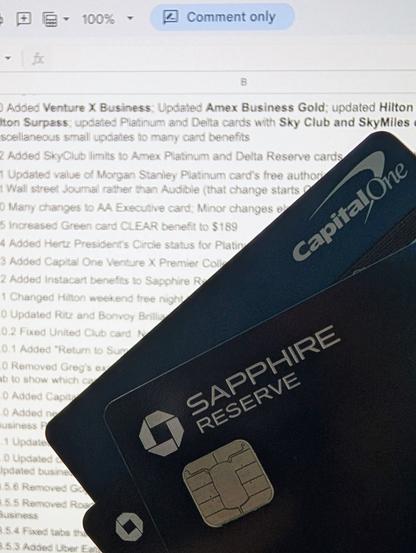The cost of travel-rewards credit cards: not just annual fees, but cognitive load
You can’t sign up for a credit card without signing up for some math–not unless you enjoy paying steep interest rates after spending more on the card than you can pay off in full each in month. But over the past three months, the three cards we use with the highest annual fees and the highest potential rewards have begun requiring some advanced arithmetic.
In March, Chase increased the annual fee on the the United Club business card I use for work while dangling an expanded set of credits for third-party purchases. Then Capital One went in the other direction, keeping the fee on our Venture X cards intact but taking an axe to its airport-lounge benefits. Finally, this week saw Chase reveal an even steeper hike to the annual fee on our Sapphire Reserve cards, again theoretically offset with an even wider set of deals and credits.
So far, all three of those cards have been profitable for us, in the sense of yielding mile or point redemptions for travel we were going to do anyway that exceed their annual fees. But with my business card’s “AF” going from $450 to $695 and the Sapphire Reserve’s leaping from $550 to $795 (plus an increase in its authorized-user fee from $75 to $195), all those calculations require a redo.
The first step in answering the most important question in the credit-card business–am I getting a positive return from these slabs of plastic and metal?–is to ignore the “up to” estimates of potential rewards for each card, what View From the Wing blogger Gary Leff calls the coupon book pitch. Instead, only look at credits or discounts offered for expenses you already incur.
For example, United’s offer of $150 a year back in ride-hail credits is worth counting, looking at how often I use Uber and Lyft (FYI, Waymo robotaxis qualify for this too). But I’m not banking on $100 in United travel credit for car rentals booked through the airline’s portal, because I rarely rent cars for work, and when I do I book them through Costco for a cheaper and more flexible rental.
With the Sapphire Reserve, there’s a $120 annual credit on Lyft that also seems worth near its advertised value. But I’m having a harder time assessing the new $300 dining credit, because the restaurants that qualify are higher-end establishments and only nine of them are in the D.C. area. Same goes for the comped Apple TV+ and Apple Music subscriptions; I would like to finish binge-watching For All Mankind, but that hasn’t been enough of a priority for me to subscribe on my own.
As for our Venture X card, Capital One taking away free guest access to its growing set of airport lounges–even if you’re an authorized user of a primary account holder–wrecks its utility on family travel. That $395-a-year card itself remains easy to turn into a free card, between the $300 annual credit on travel booked through Cap One’s travel portal and the annual award of 10,000 points that you can use to zero out $100 in travel purchases.
I get that Capital One is facing a growing problem of crowds at its lounges; I’ve had to skip its IAD lounge because there was a waitlist to get in. But this is still a drastic cutback, and rewarding the company for it by getting a second card (my wife is the primary account holder) seems wrong, even if it would cost us nothing in practice. Maybe I’m overthinking that.
As I started researching this, I came across the fabulously detailed “Which Premium Credit Cards are Keepers?” Google Docs spreadsheet maintained by Frequent Miler blogger Greg Davis-Kean–that’s how I learned that United added a Global Entry renewal credit to my card, which previously didn’t cover it. If you, too, are now wrestling with this math, it’s worth some of your time.
If you’re like me, that time will also have to include adding up the value you’ve derived from using the miles and points generated by these cards, which itself depends on the redemption rates of airlines and hotels that are themselves constantly subject to devaluation. And with the Sapphire Reserve, there are now different earning rates to calculate, including a noteworthy increase in points for travel purchases made directly with airlines and hotels.
The card issuers, meanwhile, should contemplate the cognitive-load costs they’re imposing on their customers. The alternative here is not people switching to a competing travel-rewards card but bailing out on this entire category in favor of a straightforward cash-back offering like the Citi Double Cash card my wife and I use for everyday purchases. That offers a 2% return and an annual fee of zero, both of which have stayed constant since I opened that account almost 10 years ago.
(Don’t get any ideas here, Citi.)
#airportLounge #CapitalOneVentureX #cashBackCards #ChaseSapphireReserve #ChaseUnitedClubBusiness #CitiDoubleCash #creditCard #creditCards #loungeAccess #premiumCreditCards #travelRewardsCards #unbonusedSpend #UnitedAirlines
